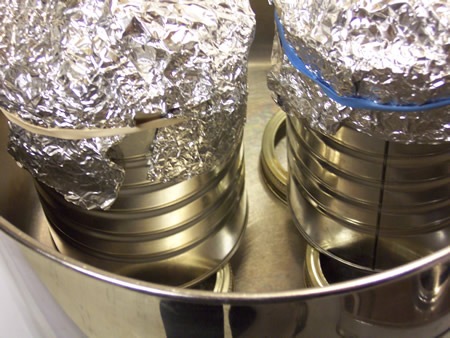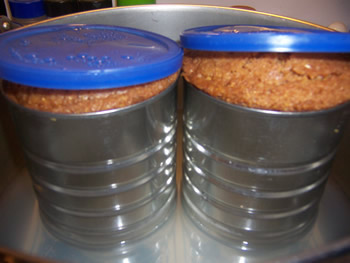Home > How to Steam Bread
Steamed Bread is baked above water in a pot rather than in the dry heat of the oven. Steaming the bread makes it flavorful and ultramoist without being gummy or packed with fat.

In early American days, ovens were uncommon. Even in some parts of the world today, steaming the breads in hot water is the only way some people are able to get their daily bread.
Another method for steaming breads is to simulate a brick oven as you would for brick oven pizza.
Try one of these steamed bread recipes or feel free to submit a recipe.
Steamed Bread Recipes
Low-Fat Date Nut Bread – This tasty low-fat date nut bread recipe stays nice and moist due to its “steam bath.”
Maple-Walnut Bread – This tasty low-fat maple-walnut bread is delicious spread with cream cheese (low-fat, of course!)
Steamed Boston Brown Bread – This particular brown bread is made with rye, corn, and whole wheat. It tastes great warm, sliced into rounds. Serve it for your next cookout with baked beans.

Steamed Corn Bread – Steamed Corn Bread has the color and texture of Boston Brown Bread, but it’s made with cornmeal and all-purpose flour rather than a blend of several flours. It’s also made with molasses rather than maple syrup so of course, the flavor is different!

Togus Steamed Bread – Togus Bread is a sweet, rich bread that the colonists adapted from the steamed cornmeal bread of the Algonquian-speaking peoples, who dominated most of northeastern America.

What equipment do you need to steam breads?
It’s not hard to make steamed bread. You just need a few iitems that you probably already have in your kitchen.
The first item you’ll need is something to hold the batter such as a pudding mold, or a one-pound coffee can, a couple of large soup cans or tomato cans. You can even use a 9-by-5-inch loaf pan or mini loaf pans.
Next, you’ll need something to act as a heat-proof trivet. This could be a few metal canning rings, wadded up aluminum foil, or even a cake rack. You’ll put the trivet in the bottom of the pot and then set the pudding mold or cans on it. The purpose of the trivet is to keep the cans from coming in contact with the bottom of the pot, and burning the bread that is baking inside the cans.
The last and most important item you’ll need to steam breads is a pot to steam them in. You can use a large dutch oven or other pot, a slow-cooker or pressure cooker. The pot must be big enough to fit the breads in their molds, the makedo trivets, the water the breads cook in, and it must have a tight-fitting lid.
The reason you need a tight-fitting lid is because the batter-filled cans are half-submerged in simmering water, and the pot lid needs to trap the steam. A loose lid would allow the steam to escape.
What types of vessels or pots can be used for steamed bread?
There are three types of vessels you can use to steam breads: a dutch oven or large pot on the stovetop, a slow cooker or a pressure cooker.
Steaming breads using a large pot on the stovetop: Place the trivet in the bottom of the pot, then place the covered breads on the trivets and pour enough boiling water into the pot to come halfway up the sides of the cans. Then, cover the pot and steam for 3 to 3 1/2 hours for breads in large coffee cans or loaf pans, 1 3/4 to 2 hours for breads steamed in smaller cans such as large soup or tomato cans or small loaf pans. Then test the bread with a skewer to make sure it’s done completely. If it’s not done, recover it and continue steaming. Then check again after about 20 minutes.
Steaming breads using a slow-cooker: Place the trivet on the bottom of the slow-cooker and put the batter-filled mold or loaf pan on the trivet. Poor enough boiling water into the slow-cooker to come halfway up the sides of the mold or pan. Cover the slow-cooker and using the high setting, steam the bread for 2 1/2 to 3 1/2 hours depending on the size of the mold or pan. Remove the mold from the slow-cooker and test and cool as directed in the recipe.
Steaming breads using a pressure cooker: Place the trivet on the bottom of the pressure cooker, then place the batter-filled cans or loaf pan on the rack. Then pour boiling water into the cooker to come halfway up the sides of the molds or cans. Lock the pressure-cooker lid and bring to high, steam-emitting heat, then immediately lower to the mid range. Cook 40 minutes on midrange pressure for large breads and about 25 minutes for smaller breads.
Turn off the pressure, and let the cooker return to normal pressure. Unlock the lid, remove the bread and test it to see if it’s done. Cool as directed in the recipe. If it’s not done, recover the bread and bring the cooker back up to pressure, then lower to mid-range for 1 to 5 minutes. Then turn off and let it return to normal pressure and test it again.
Tips for steaming breads
- Bread recipes that call for 3 cups of flour and meal, will fill one 9-by-5-inch loaf pan, one 1-pound coffee can, three 20-ounce cans, or five 12-ounce cans.
- Make sure the molds and foil are greased well.
- Using a pressure cooker will reduce the cooking time; however, it is a bit of a hassle to make adjustments when the bread is not quite done.
Sources:
Clayton, Bernard. Bernard Clayton’s New Complete Book of Breads. 2006 Simon & Schuster.
Dragonwagon, Crescent. The Cornbread Gospels. 2007 Workman Publishing Company, Inc.
Hensperger, Beth. The Pleasure of Whole Grain Breads. 2000 Chronicle Books.

LC says
More of a question really. Can bread recipes for the oven be steamed in a steamer, and can bread recipes for the steamer be baked in the oven? Would any changes be needed either way to convert to the other method of cooking, i.e. for steamer or for oven? Thanks for any responce.🙂
Cathy says
Hello, thank you for your inquiry. I have not tried either method for steaming bread so I’m not really sure how it would work.
CeCe says
I found a recipe for Harvest Bread that used oven baking. I then found directions for Boston brown bread made in an Instant Pot. So I took the oven recipe, poured it into a 6 cup silicon Bundt pan and placed it in the instant pot. There was about 2 cups of batter left over and I poured that into muffin pans and baked in the oven At 400° for 30 minutes. Everything came out great.
Cece says
I used Harvest Bread recipe on the King Arthur website which calls for steaming in the oven, the traditional way, but I steamed it in my instant pot by adding one cup of water, placing a trivet and then a 4 cup silicone Bundt pan on that. High pressure, 30 minutes. Came out great. I had left over batter, poured it into a greased muffin pan and baked at 400 for 30 minutes.
Virginia says
I’m looking for safe cans in which to steam Brown Bread. Most cans now have liners of different kinds that I’m thinking are not safe to use for steaming bread. Do you know of any food item sold in just plain aluminum cans that would be safe for steaming that don’t have seams that might not be safe? I’ve searched and searched on line and find no plain aluminum cans for sale in which to steam bread.
Shaker says
Hello Virginia:
Try coffee cans. Torke produces a decent coffee @ a reasonable price. (26 Oz cans) The cans are tin, so you’ll need a can opener to open them.
Another place to find UNUSED tin cans, is to lo find a local vegetable producer / canner. They go through millions of cans of all sizes per year. (By the pallet.) Heck, if you only need 2, or 3 cans, you might even be able to get them for free.
It always pays to check around.
Mac says
I use 16 or 24 ounce can-freeze wide-mouthed mason jars (the tapered kind) and steam them in my hot water bath canners, which has the rack specially made for jars. Works perfectly.
Cathy says
That’s a great idea to use your hot water bath canner to steam bread! Thanks for sharing your process. I’ll have to try that sometime.